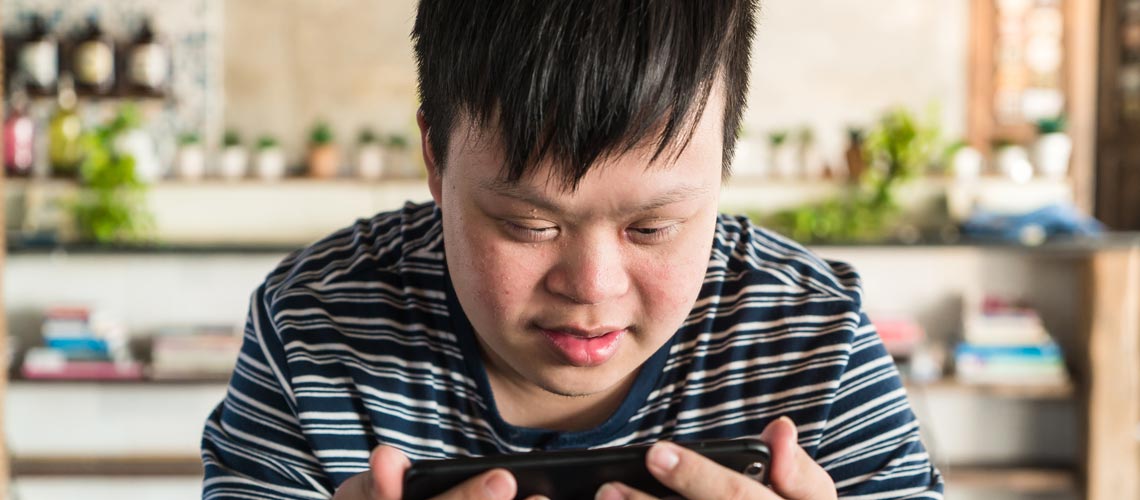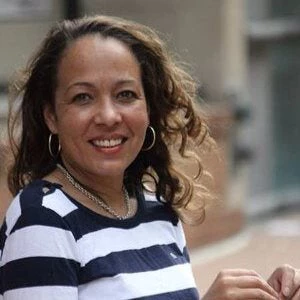 Boy with Down syndrome holding a smartphone. Photo: © Shutterstock
Boy with Down syndrome holding a smartphone. Photo: © Shutterstock
A woman with a mobility disability narrated her frustration with paying a hefty sum for an accessible taxi to get to the ID registration center, only to wait in long lines and be turned away and asked to come yet another day.
An older man with albinism shared his fear of the irreversible damage to his skin as he was forced to wait under the sun because there was no accommodation provided at his nearest ID enrollment center.
A child with Down’s Syndrome was unable to register for his ID at all because the software to capture his photo kept stalling in error and the enrollment officer sent him away.
These are just a few examples of experiences shared by persons with disabilities during national consultations conducted jointly with the ID4D Initiative and the Social Sustainability and Inclusion Global Practice. These types of consultations across Africa helped form a new guidance note on Creating disability-inclusive ID systems, to help practitioners make inclusion of persons with disabilities a reality.
One billion people globally are estimated to not have government recognized proof of identity. Of these, persons with disabilities are more likely to experience greater barriers obtaining and using IDs . And since IDs are often used to access services and benefits, their absence can become yet another roadblock to the agency and empowerment of persons with disabilities. Having an ID also has the potential to transform the life of a person with a disability. As one traditional leader in a leprosy community in Nigeria shared during a national research study:
“You know the stigma we face (as a person with leprosy), we are already discriminated against. When you have your national ID card, it can give you the confidence to stand among other people. You can even go to the court to make claims, even go to the police station to call a police person to come and assist you because having an ID gives you confidence.”
ID systems need to be thoughtfully designed from the onset to ensure accessibility and inclusion of persons with disabilities , in line with the Principles on Identification for Sustainable Development.
Entrenched barriers complicate access to IDs
Persons with disabilities comprise over 15% of the world’s population, and this rate is even higher in many developing countries. In Nigeria alone, there are an estimated 25 million persons with disabilities. This significant portion of the population faces systemic and long-entrenched barriers to accessing IDs. Inaccessibility of enrollment centers, both in terms of distance from home and barrier-free premises and services, creates a challenge. They often face higher indirect costs to completing long or complex procedures, obtaining accessible transport, and paying fees for assistance with completing forms or obtaining a favorable position when queuing. Frontline staff may not be trained in addressing the needs of persons with disabilities or in exception handling procedures for bypassing issues with capturing biometrics, for example. Societal stigma and misconceptions of persons with disabilities, and even their need for identification, often dominate how services are provided and interactions conducted.
Practitioners should apply a whole of system approach for disability-inclusive ID
- Implementing inclusive enabling legal and governance frameworks can pave the way for progressive realization of identity-for-all by ensuring non-discrimination on the basis of disability.
- Engaging persons with disabilities during planning and throughout implementation of ID systems is critical. Countries can start by using a disability lens in assessments, engaging disability experts early on, and ensuring disability representation in any task forces or working groups.
- Educating persons with disabilities about ID systems requires accessible information dissemination and offering messages in multiple formats to reach persons with different types of disabilities.
- Adapting ID-related processes and technologies. This can mean bringing enrollment closer to the people, ensuring accessibility of centers and shorter queues, providing sign language interpreters, and training staff on making reasonable accommodations as required. Ensuring that technology is an enabler and does not become another obstruction requires properly applying exception handling procedures.
We can also support innovative solutions, such as that proposed by Special Olympics Nigeria, one of the winners of the 2020 Mission Billion Challenge, for successful outreach and inclusion of persons with intellectual disabilities.
As we emerge from celebrating the International Day of Persons with Disabilities, let’s work together to ensure the inclusion of persons with disabilities in all ID systems.
RELATED
Creating disability-inclusive ID systems
The World Bank and Social Sustainability and Inclusion



Join the Conversation